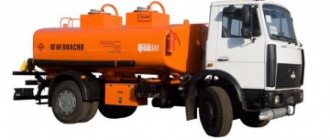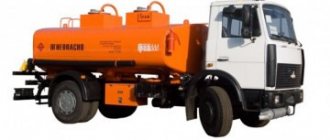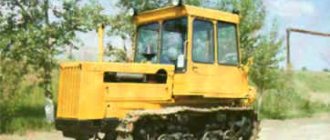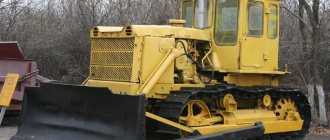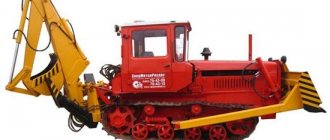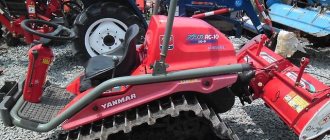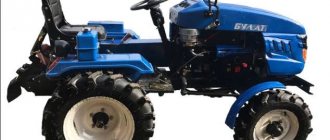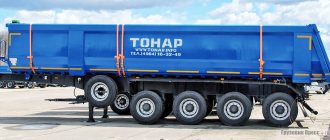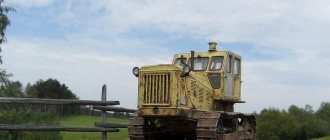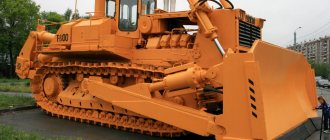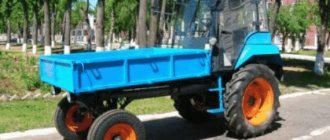When performing earthmoving work, as well as when solving problems in construction or agriculture, the use of special equipment is a vital necessity. The presence of additional equipment allows you to optimize the work process and achieve the desired result in the shortest possible time.
About the history of the creation of the T-130 tractor
When the young Soviet state set out to build a plant for the production of industrial tractors (and this happened in 1929), our leaders did not “reinvent the wheel”, using the rich experience and knowledge of American specialists.
The Great Depression of 1929-1933 was just breaking out in the United States. Therefore, Detroit happily took on the design of the Stalingrad Tractor Plant (agricultural tractors) and the Chelyabinsk Tractor Plant (industrial tractors). Albert Kahn's reputation was impeccable: before the Great Depression, this company designed and took part in the construction of most of Henry Ford's factories.
The basic model for ChTZ was the American Caterpillar-60 tractor. The first such machine, called "Stalinets-60", rolled off the assembly line of the new plant on May 15, 1933. Until 1956, all new tractor models produced by the plant itself bore the name of the leader of the Communist Party. During the Great Patriotic War, the production capacity of the enterprise was used to produce heavy KV tanks, self-propelled artillery units and tractors for howitzers.
The absolute bestseller of the Chelyabinsk plant was the multifunctional tractor T-100M, the famous “weaving”, the holder of many world records, including mass production: from 1963 to 1983, 412,145 such machines were made. The T-130 tractor is a direct descendant of the “weaving”, an improved version of it developed and put into production in the context of ongoing production of the T-100M.
Attachments
The T-130 tractor is equipped with a separate-aggregate hydraulic system. In addition, the model is equipped with front and rear hitches, as well as a pendulum or rigid type tow hitch. In view of this, the tractor can be equipped with a bulldozer and other types of attachments.
The presence of additional attachments significantly simplifies the technological process and significantly expands the existing functional potential. The T-130 tractor can be equipped with various variations of dumps designed for a wide range of jobs. If necessary, you can install a straight, hemispherical or coal blade. A swamp blade or a three-prong ripper can also be used for this. However, if the tractor is transported on a railway or low-load vehicle platform, the attached attachments will have to be dismantled.
Technical characteristics of the bulldozer T-130
Compared to its predecessor, the T-130 tractor has noticeably increased its power. Until 1981, it was equipped with a D-130 diesel engine, in 1981-1988 - a D-160 engine with a power of 140 horsepower. Naturally, the weight of the tractor also increased - up to thirteen tons. The problem of ergonomics in the cockpit was successfully resolved.
Characteristic features of the technical design of the T-130 tractor are a high safety margin of all components and mechanisms, reliability and unpretentiousness, high maintainability and structural continuity of the T-100M-T-130-T-170 models.
For consumers, this literally means the following: spare parts for the discontinued T-130 can be easily found in our time. The ability to install new units on old machines is not a problem.
General technical parameters of the T-130 bulldozer
- Traction class - 10 tf.
- Dimensions (Length x Width x Height, in mm): 5200 x 2480 x 3085.
- Base, in mm: 2480.
- Track, in mm: 1880.
- Ground clearance, in mm: 415.
- Specific pressure on the ground, in MPa: 0.05.
- Engine type D-130 and D-160: four-stroke diesel, turbocharged, multi-fuel.
- Specific fuel consumption, g/kW*h (g/l.s.h.): 244.3 (180).
- Fuel: for the main engine - diesel, for the starting engine - a mixture of any gasoline with motor oil in a ratio of 1:15.
The T-130 tractor is equipped with refueling tanks of the following volume:
- Tank for diesel fuel - 290 l.
- Cooling system capacity - 60 l.
- Engine lubrication system tank - 32 l.
- Two final drive tanks of 12 liters each.
- 100 liter hydraulic tank.
T-130 tractor engines
As already noted, cars of earlier years of production are equipped with D-130 diesel engines; since 1981 they were replaced by the more powerful D-160. The main advantages of these engines are their reliability and unpretentiousness. Over the course of many years of operation, they demonstrated stable operation in the most extreme conditions: in the Karakum desert, while laying irrigation canals, and beyond the Arctic Circle, working in the oil and gas industry.
However, in the conditions of the Far North, machine operators initially struggled with starting the engine in severe frost conditions. Therefore, a pre-start heater for the engine and all technical fluids began to be installed on the T-130 tractors intended for shipment to the harsh northern regions. The D-130 and D-160 engines demonstrated stable operation on diesel fuel of any quality, and even kerosene or gas condensate.
The D-160 engine is the base engine of the T-130 bulldozer since 1981.
Transmission T-130
The T-130 bulldozers are equipped with an 8-speed mechanical or hydromechanical transmission, with a permanently closed clutch, four clutch discs (2 driven and 2 driven) and a four-shaft gearbox. The transmission package includes a two-stage final drive, dry multi-disc final clutches, and a bevel gear.
As already mentioned, the T-130 has a four-shaft gearbox, which allows you to change the speed of four reverse gears and eight forward gears. The maximum traction force is achieved by the gearbox at a bulldozer speed of 2.6 km/h - 128.2 kN.
Chassis and steering of the T-130 bulldozer
The suspension of the T-130 bulldozer is semi-rigid, with a balanced transverse spring. It is made of two stamped side members combined with the rear axle housing.
The caterpillar track consists of stamped track links connected to each other by metal pins.
Steering of the tractor is provided, as in previous and subsequent ChTZ models, by a lever system using a set of belt-type clutches.
In order for the bulldozer to make a full turn, a rotary coupling is used. Such a device is located on the rear axle and is connected to the drive gears using shafts. At the same time, using the band brake (which is located around the rotary coupling), the tractor can be turned almost in one place.
Operator's workplace on the T-130
Everything is relative. If, in comparison with modern tractors, the T-130 cabin seems extremely sparingly and “Spartan” equipped, then, in comparison with the previous model, the T-100M, the operator’s workplace was much more comfortable and convenient for working in various conditions.
The ergonomics of the workplace was carefully worked out with a refined arrangement of all levers. The driver's seat is equipped with an adjustable backrest configuration. The air conditioning and heating system ensures a normal temperature for the operator’s well-being, even in severe frosts. Rubber seals serve the same purpose, as well as protection from noise and dust. The cabin is equipped with a reinforced safety cage.
Workplace of the operator of the T-130 bulldozer.
Hydraulics and attachments of the T-130 tractor
The set of working equipment is a separate unit, hydraulic, designed to perform work with two types of mounted systems: rear and front; in rigid or pendulum design.
The separate-unit hydraulic system is designed to ensure the operation of mounted and trailed equipment. A bulldozer blade of two types, with a standard width of 2.5 or 3.2 meters, is installed on the front linkage.
Various rippers and uprooters are mounted on the rear linkage; pipe-laying, piling systems, timber transportation equipment, etc. There is positive experience of using the pure “industrialist” T-130 in agriculture: for plowing previously unused virgin lands.
Engine
The first cars of this brand were equipped with D-130 engines, but already in 1981 they were replaced with more powerful D-160 diesel engines. Their main advantages are unpretentiousness and guaranteed reliability. Over many years of operation, the engines demonstrate quite stable operation, despite extreme conditions.
But in severe frosts, the machine operators were unable to quickly start the mechanism. Because of this, those tractors that were sent to the northern regions were equipped with a pre-start heating system for both the engine and any technical fluids. The units demonstrate reliable operation on diesel fuel of any quality; they can be started on kerosene or gas condensate.
| Options | Values |
| Power | 170 kW |
| Number of cylinders | 4 |
| Cylinder volume | 13.5 l |
| Piston diameter | 145 mm |
| Piston movement | 205 mm |
| Crankshaft speed | 1070 rpm |
| Generated torque | 1098 Nm |
| Engine weight | 1.95 t |
| Fuel consumption | 236.3 g/kWh |
Modification of the T-130B and the “next generation” - T-170
A modification of the T-130B was developed for wetlands. It differs from the basic one in wider, “swamp-going” tracks and a more powerful D-180 engine. It should be noted that despite its “not weak” mass, the T-130B bulldozer had excellent maneuverability, thanks to a record low specific ground pressure: 0.5 MPa per square centimeter of surface.
T-130B, with extended tracks and D-180 engine.
The T-130 became the basis for the development and launch of a more advanced and modern model of industrial tractors - the T-170. Which, if not for the notorious “perestroika” and the subsequent collapse of the USSR, would also have become one of the world’s best-selling powerful tractors.
Transmission
A manual transmission is typical for the T-130. The technical characteristics of the tractor are complemented by twelve gears, of which eight are forward and four are rear. The gearbox operates on the basis of moving gears. This ensures smooth gear shifting.
The model's transmission includes the following elements in its design:
- four-shaft gearbox;
- the final drive has two stages;
- dry side clutches with several discs;
- clutch;
- rear axle
A distinctive feature of the bulldozer from modern models is the presence of a rotating mechanism. It allows the tracks to be given different speeds. But this mechanism also has its downside. It consists in the rapid wear of many elements. The engine and transmission are connected using a friction clutch.
Machine operators - about the experience of operating the T-130 bulldozer
It was one thing to use the T-130 in the Soviet Union, when diesel fuel cost mere pennies and was generally “official”, and quite another thing in the new Russia, where fuel costs a lot of money and is purchased with your own, “hard-earned” funds. In this regard, current owners of the T-130 note that this bulldozer has greater productivity, but also requires large volumes of excavation work, otherwise its use will simply be unprofitable.
If we compare this model with a bulldozer based on the DT-75, the T-130 works much more efficiently and productively. However, it also “eats” more than twice as much diesel fuel. Therefore, it makes sense to use it, first of all, on large and “impact” construction projects: the construction of dams, road junctions, cleaning and planning of large sites for large construction, laying pipelines, etc.
Machine operators who worked on the T-130 in the Far North confirm the difficulties of starting the engine in extremely low temperatures. However, a person adapts to everything, and, according to one of the machine operators, “this procedure, of course, is not easy at first glance, but over time it happens automatically and becomes no more difficult than turning the ignition key and starting the engine of a passenger car.” "
A significant problem with T-130 engines is that they (or rather, their turbine) are “afraid” of prolonged operation at idle speed. If you keep the engine idling often and for a long time, the turbine begins to leak oil and eventually fails.
The fact is that if the engine runs at low speeds, then the lubricating oil practically stops flowing into it. The turbine begins to run dry, so wear on parts increases and breakdown may occur.
An important drawback is also that the track shoes are attached to bolts, which periodically loosen and unscrew. Therefore, you have to constantly monitor the fastening of the shoes, check their integrity and tighten them.
T-130 on road construction.
However, in general, with the exception of minor shortcomings, everyone notes the amazing unpretentiousness and reliability of the bulldozer, coupled with its truly “monstrous” power and performance. This is confirmed by data preserved from distant Soviet times on the conclusion of the state commission for the acceptance of the new model of the T-130 tractor, which stated: the tractor passed all tests, exceeding all stated indicators and exceeded all expectations.
Electrical equipment
Unified auto components are also typical for the electronic system of the T-130 tractor. The electronic equipment of the bulldozer is controlled via a single-wire twelve-volt circuit. It consists of an energy source, a rectifier, and a generator. These elements are necessary for starting the engine, heating the cabin, ventilation, operating the window wipers, and sound signal. There are also additional electronic fuses. They serve to protect the system from short circuits.
T-130 bulldozers on the modern secondary market
Since at one time hundreds of thousands of units of T-130 bulldozers were produced, and in the 21st century this old but reliable tractor can be purchased in almost any region of Russia and other republics of the former Union.
There are many advertisements on the Internet for the sale of such bulldozers. The price varies from 250 thousand rubles (for a tractor of advanced years and in a rather “tired” technical condition) to 1 million rubles (for a still quite “vigorous” T-130 with an updated engine that has undergone a major overhaul). There are many advertisements for the sale of all kinds of spare parts and components for the T-130.
Analogs
There are many analogues of the T-130 bulldozer. First of all, this is a significantly improved version of this model - the TM-10 bulldozer. The machine is more maneuverable and productive; it does not have the disadvantages inherent in the older model.
Another analogue of the T-130 is the B10M bulldozer and its various modifications (B10M 0111-1E and others). This model is somewhat inferior to the TM-10.
In addition, there are foreign analogues of the T-130. These are Caterpillar D6R models and Chinese Shantui SD16 and Komatsu D65 models. The performance of the latter, according to the manufacturer, is twice that of the T-170. And the Caterpillar D6R completely replaces three T-170 bulldozers. True, the cost of foreign analogues is 1.5-3 times more than domestic ones.
